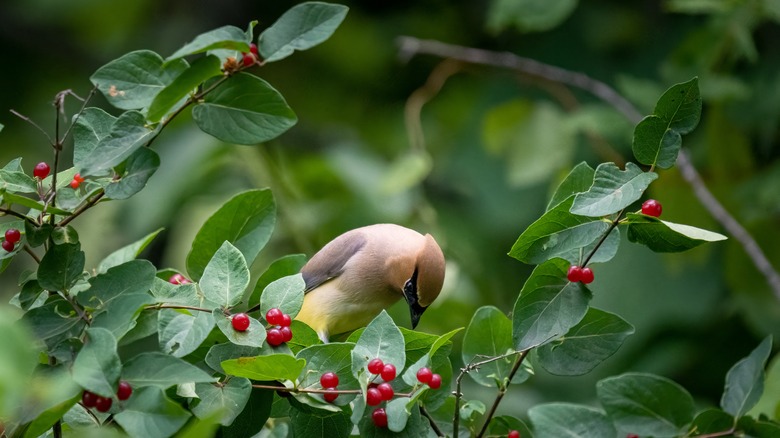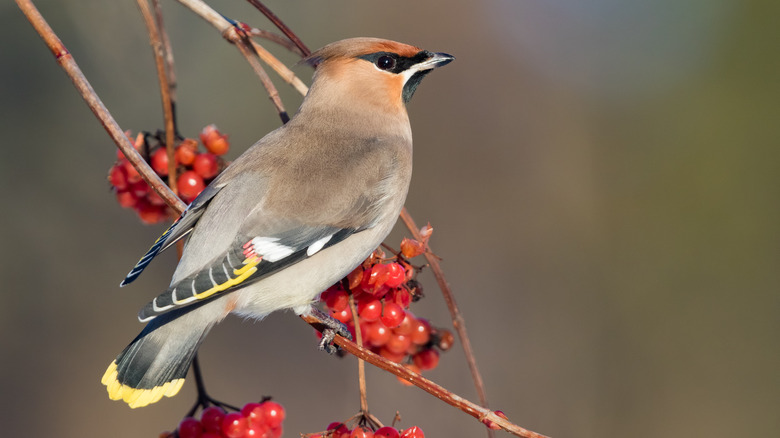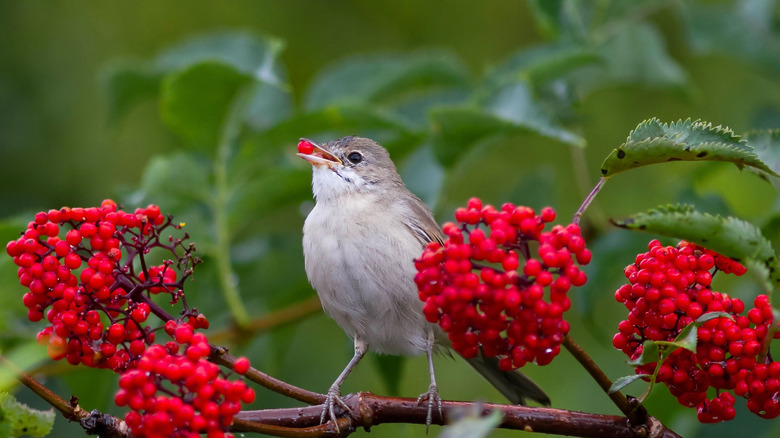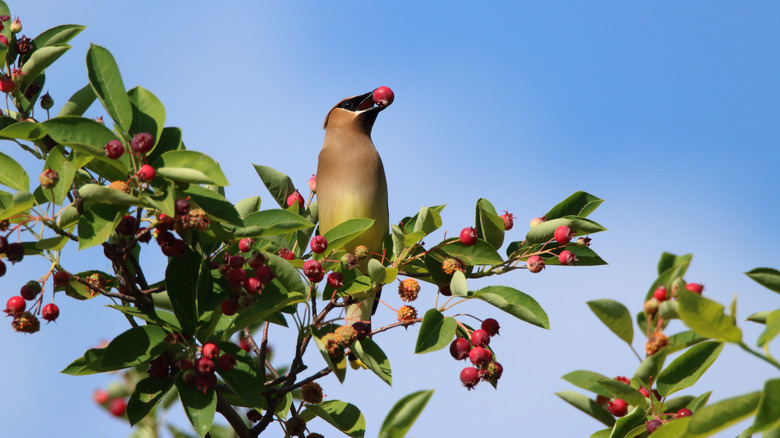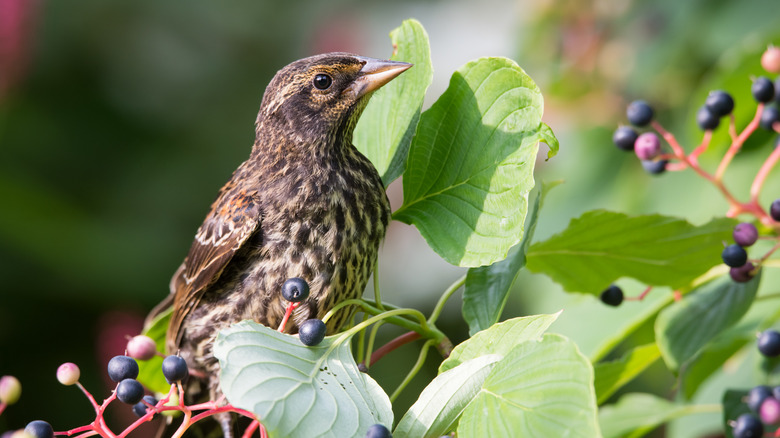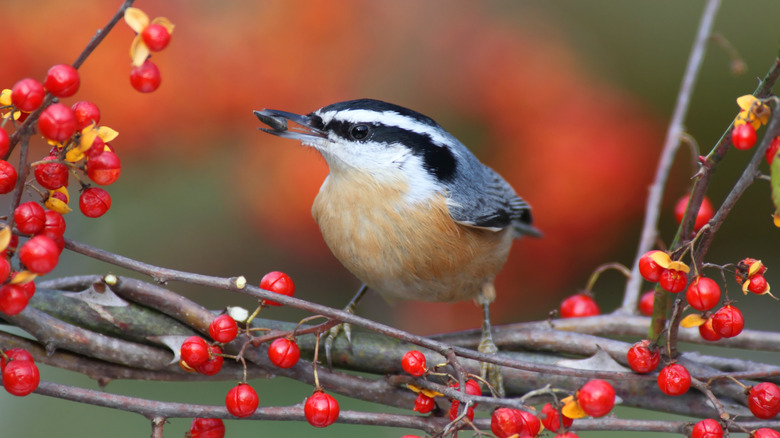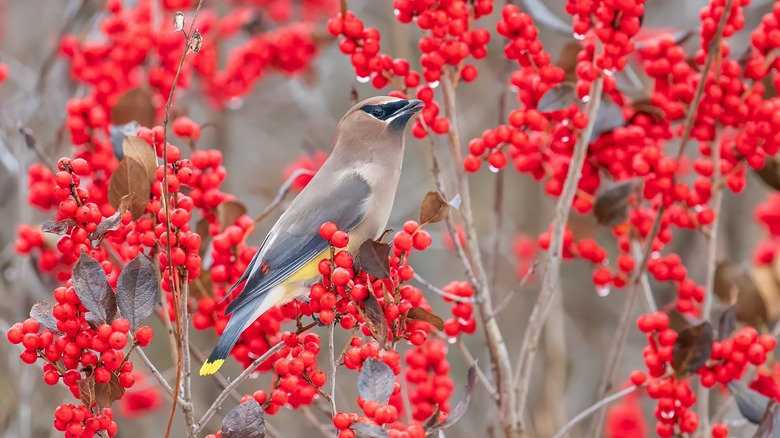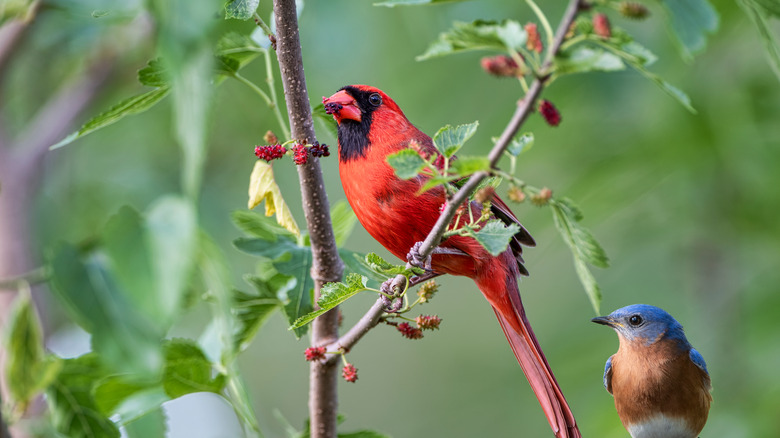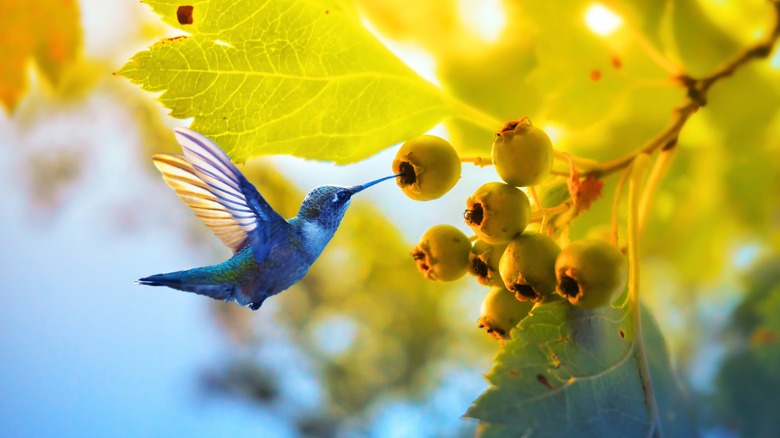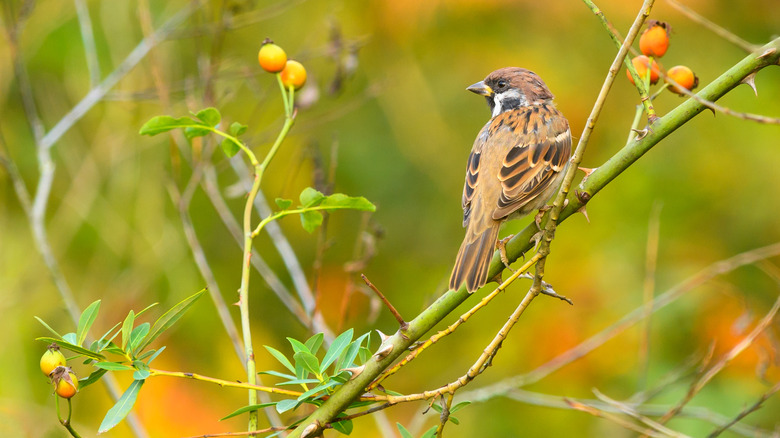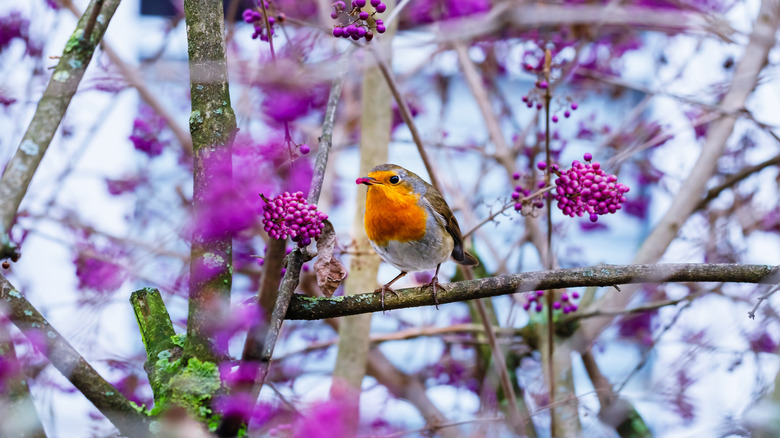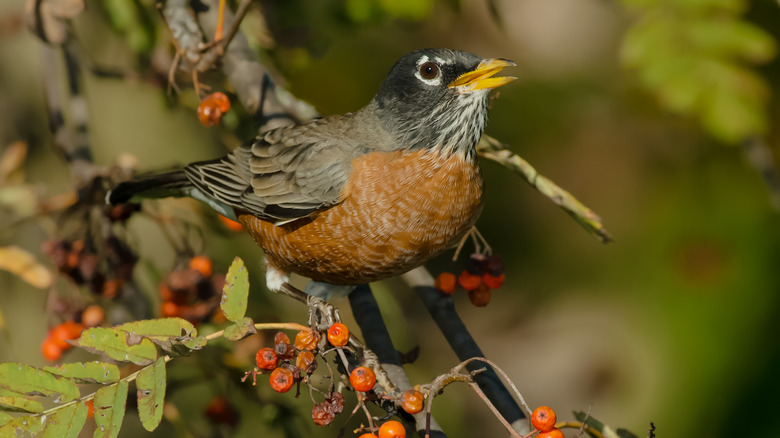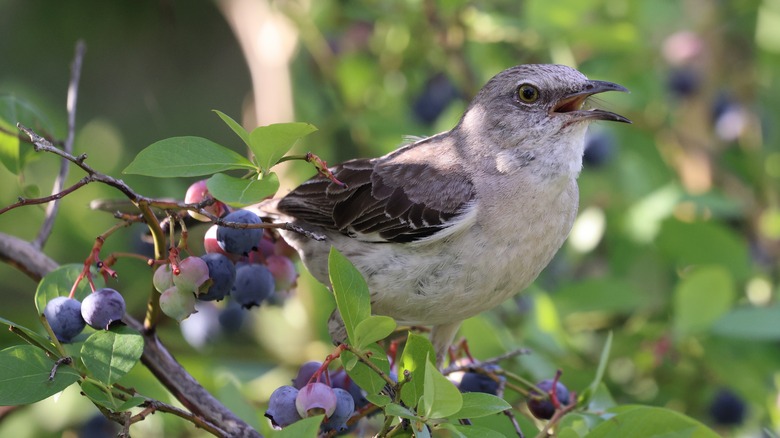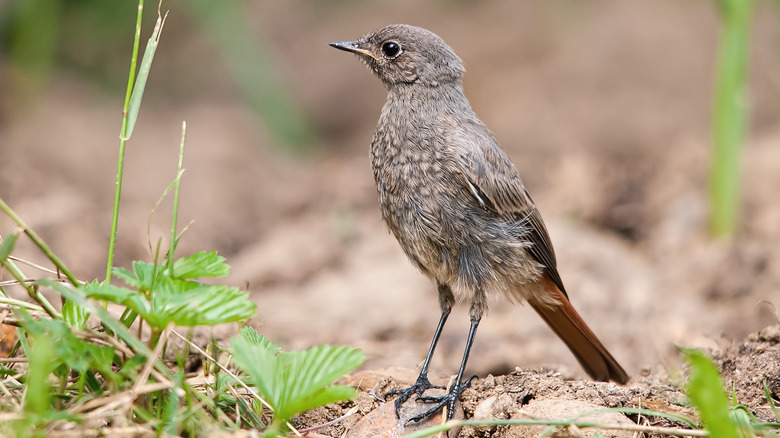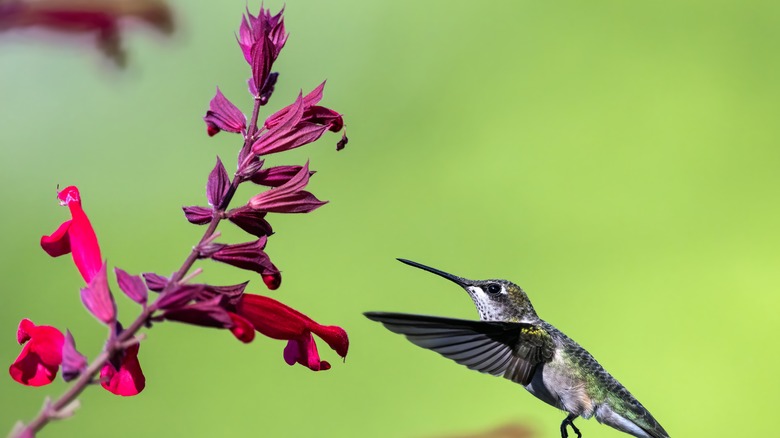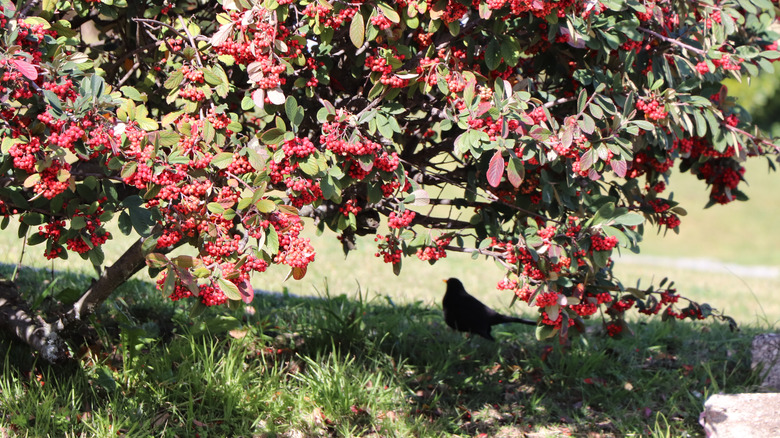Add These 15 Berried Plants To Your Garden To Attract All The Birds
Berried plants are a delightful addition to most gardens, as they bring a splash of color, yield sweet fruit harvests, and attract various wildlife. Among the latter, birds are a common guest. A carefully curated selection of berry plants will invite the feathered creatures to feast on their fruit and make nests in their branches, whether they're overwintering in your area, stopping by your yard on their way south, or simply enjoying the summer months. For those who love bird watching, adding plants with berries to your yard could draw in a variety of different species.
But selecting the right plants can be a chore. Many bird favorites are invasive in different parts of the nation, and some only thrive in specific hardiness zones. We've done the legwork and put together a lineup of 15 plants that are known to draw in birds with their berries during different times of the year. All of the plants in our collection are native, and we've made the effort to point out any invasive look-alikes for your reference. Apart from attracting birds to your garden, each of the shrubs, vines, and trees below will also adorn your outdoor space with foliage, blooms, and colorful fruit.
1. Native viburnum
Viburnum berries attract birds late in the year when they're at their ripest. After producing luxuriant foliage and white blooms in the warm season, viburnum plants light up with purple or crimson berries in the fall. As the cold sets in, these berries remain edible throughout winter. This quality makes viburnum berries a particularly enticing snack and nutrient source for birds who spend the winter in the region instead of migrating south. Note that several viburnum species are invasive in the U.S., so opt for the native varieties such as Mapleleaf (Viburnum acerifolium) or Blackhaw viburnum (Viburnum prunifolium). Most varieties are hardy in zones 4 to 8.
2. Elderberry
Elderberries (Sambucus nigra) make for a yummy meal for tanagers, grosbeaks, cardinals, cedar waxwings, and other birds during the late summer months. Birds that lay eggs well into the end of summer — like cardinals — get vital nutrients from elderberries as they prepare for their final brood. Meanwhile, migratory cedar waxwings replenish their reserves on elderberries before making the trip south. Elderberry plants are native virtually everywhere in the contiguous U.S. and Canada, apart from the Pacific Northwest. However, you can still grow them successfully on the West Coast because they're hardy in USDA zones 4 to 7 and tolerate most soil conditions.
3. Serviceberry
Serviceberry or juneberry (Amelanchier) is a small tree that attracts mockingbirds, thrushes, orioles, and cedar waxwings, among other birds, in the spring and summer. In the spring, the tree's tender white blooms draw birds indirectly by attracting various prey insects. As the weather warms in June and July, the serviceberry blooms turn into the characteristic maroon berries that provide a valuable source of nutrition for birds in your garden. You can harvest and cook serviceberries, too — they're delicious in jams and as pie filling. Serviceberries are hardy in USDA zones 5 to 9 and thrive in diverse soil conditions.
4. Pagoda dogwood
Hardy in zones 4 to 8, the Pagoda dogwood (Cornus alternifolia) is a large shrub whose dark blue berries are a hit among birds like cardinals, juncos, and catbirds. Dogwoods bloom throughout late spring, and their berries ripen enough for birds' liking by July and August. At this time, the berries nourish birds who are laying their last batch of eggs for the year and those getting ready to fly south ahead of the approaching cold. Note that while the Pagoda dogwood is a non-invasive plant you can grow safely, some dogwood species — like the Kousa dogwood (Cornus kousa) — are considered invasive. Stick with the Pagoda variety instead.
5. American bittersweet
Hardy in zones 3b to 8, American bittersweet berries (Celastrus scandens) offer a precious source of nutrition for overwintering birds. Growing this woody vine near your home is bound to invite some guests during the year's coldest season. Depending on where you live, you may observe various songbirds and grouse snacking on the orange fruit. When choosing a bittersweet plant, be sure to pick the native variety and not the similar-looking but invasive Oriental bittersweet (Celastrus orbiculatus). You will need to grow both male and female plants to get fruit from the bittersweet plant, since they're dioecious.
6. Winterberry
Add two dioecious winterberry (Ilex verticillata) shrubs to your garden in zones 3 to 9 to invite birds during the year's bleakest months. Winterberry, or winter holly (not to be confused with the invasive Christmas holly, Ilex aquifolium), is a shrub with bright-red berries adored by robins, woodpeckers, and Eastern bluebirds, among others. The berries ripen during the later fall months, but the birds won't eat them yet. It takes a few freeze-thaw cycles to break down the berries' rigidity and make them more palatable for birds. So, expect to see them feeding on your winterberry shrub in the dead of winter, when the berries are sufficiently soft.
7. Red mulberry
If your property can accommodate their large size and you live in zones 4 to 9, red mulberry trees (Morus rubra) will offer an irresistible buffet for blue jays, robins, cardinals, and other fruit-loving species. Red mulberry is a deciduous tree that grows to over 60 feet in height and blooms throughout spring and early summer. Its berries appear in the summer and ripen between July and August, at which point you'll see your mulberry trees hosting a wide assortment of birds. If you plant red mulberries, it'll take four years before they bear fruit. However, they will produce berries for almost a century afterward.
8. Chokeberry
Planting a chokeberry tree (Aronia) will entice birds to visit your orchard for a late-winter meal. Hardy in zones 3 to 8, chokeberries are large shrubs that flower in the spring and bear fruit in late summer. The berries ripen in the fall, and while black chokeberries fall off the branches shortly after, their red counterparts stay on the shrub until the end of winter. Birds will exhaust the natural supply of other, more nutritious fruits earlier in the cold season, then come to feast on your chokeberries in mid-winter. If you're considering planting a chokeberry tree, don't confuse it with the similar-sounding but invasive chokecherry (Prunus virginiana).
9. Prickly wild rose
A prickly wild rose (Rosa acicularis) is a lovely ornamental plant that will grace your garden in the summer and invite fruit-eating birds for a feast come fall and winter. This wild rose variety is a shrub whose large, delicate flowers bloom in late spring, then develop hips toward the end of August. The hips will stay on the stems as the cold sets in and attract various wildlife, including birds like cedar waxwings. The prickly wild rose grows well in hardiness zones 2 through 6 and tolerates all types of soil conditions — as long as the substrate is adequately-drained.
10. Beautyberry
Native beautyberries (Callicarpa americana) are a magnet for songbirds like orioles and mockingbirds on your property. These large shrubs produce uniquely-colored bright purple berries that grow around the plants' leaf axils. The fruits appear in the fall after the plants finish blooming in mid-to-late summer. The berries remain on the stem even as temperatures drop drastically. In late fall, beautyberries serve as a nutritious meal for southbound and non-migratory birds, and cardinals are known to flock to this bush. Beautyberries are hardy in zones 7 through 10, which makes them unsuitable for colder habitats. These shrubs thrive in full sun and rich, well-watered soil.
11. American mountain ash
American mountain ash (Sorbus americana) plants add a touch of vivid scarlet color to yards in hardiness zones 3 through 6 and attract various fruit-feeding birds. Cedar waxwings, blue jays, and robins are all known to snack on mountain ash berries. The fruits appear on the dioecious trees in the summer, following white spring blooms. The berries stay on the stems through the dead of winter, and that's when non-migratory birds begin to add them to their diets. If you choose to plant mountain ash on your property, opt for the American variety and not its invasive European counterpart (Sorbus aucuparia).
12. Blueberry
A blueberry bush (Vaccinium corymbosum) is an easy addition to your edible garden, and if you're willing to share the harvest, the shrub will also invite a number of birds to your yard. Blueberries are a prized treat for starlings and robins, but just about all fruit-eating birds will munch on them given the opportunity. The occasion usually arrives toward the middle of summer, when blueberries' blooms morph into berries and become ripe. These shrubs are incredibly robust. You can grow and care for blueberry plants anywhere between USDA zones 2 and 10 as long as they're in properly-drained, rich soil.
13. Woodland strawberry
Woodland or wild strawberries (Fragaria vesca) give you ready access to the delicious summer berries and a reliable attraction for wild birds. After blooming early in the spring, the flowers' receptacles swell with juice and flesh and turn into edible berries. Depending on your region, you may see robins, eastern towhees, thrushes, and grouse feeding on these miniature versions of the more common strawberry. You can grow wild strawberries anywhere in hardiness zones 3 to 10. These plants thrive in soil that's somewhat dry, with a preferred pH sitting below neutral.
14. Honeysuckle
A honeysuckle bush invigorates your garden with ornate, aromatic, late-spring blooms and draws in hungry birds toward the end of summer. As berries replace the flowers, you'll see feathered guests like thrushes, finches, orioles, and robins stopping by your property for a snack. If you plan on growing honeysuckle, be sure to avoid the invasive Japanese honeysuckle (Lonicera japonica). Instead, opt for a native variety, like trumpet honeysuckle (Lonicera sempervirens). You can grow these vines in USDA zones 4 to 9. They grow best in full sun or partial shade with soil that's well-watered but adequately-drained.
15. Buffaloberry
Buffaloberries (Shepherdia) will beckon various migratory and overwintering birds to your property in the fall. These tall dioecious shrubs produce pretty red berries in the middle of summer after blooming during the spring. As fall rolls around, the berries ripen, and the shrubs light up in bright-red color. Many songbirds enjoy these berries, use the shrub's foliage as protection from predators, and build nests on their branches. Buffaloberry likes full sun but thrives in colder climates and is hardy between USDA zones 2 and 6. Be sure to plant these shrubs in soil with an above-neutral pH and avoid overwatering.
